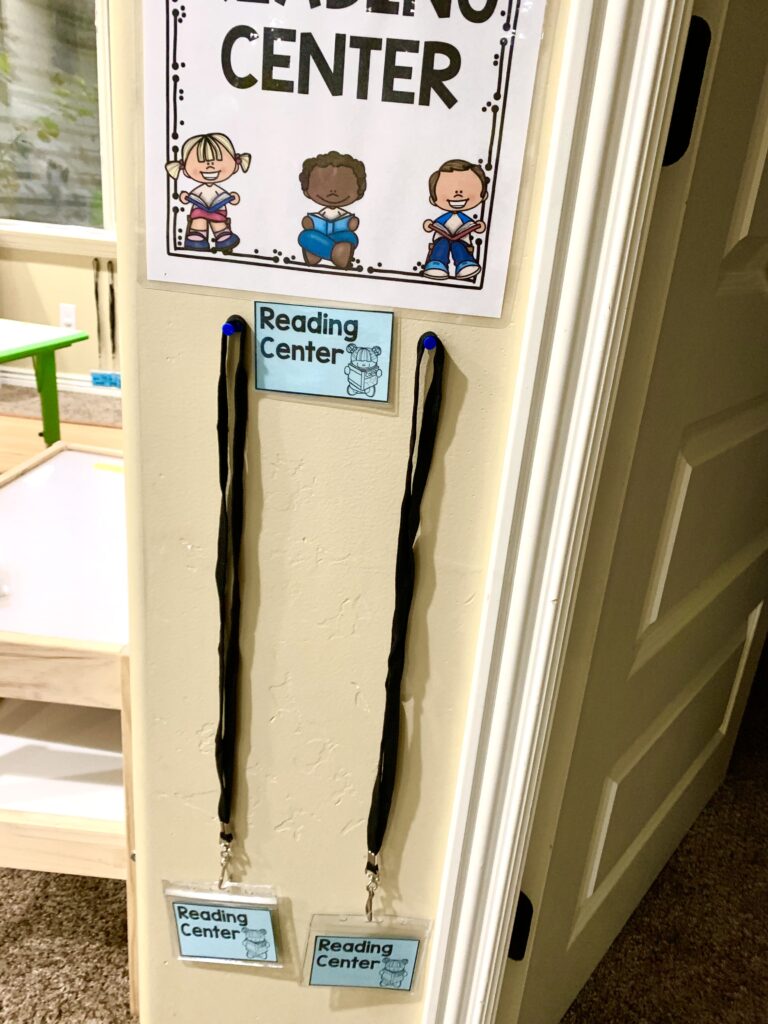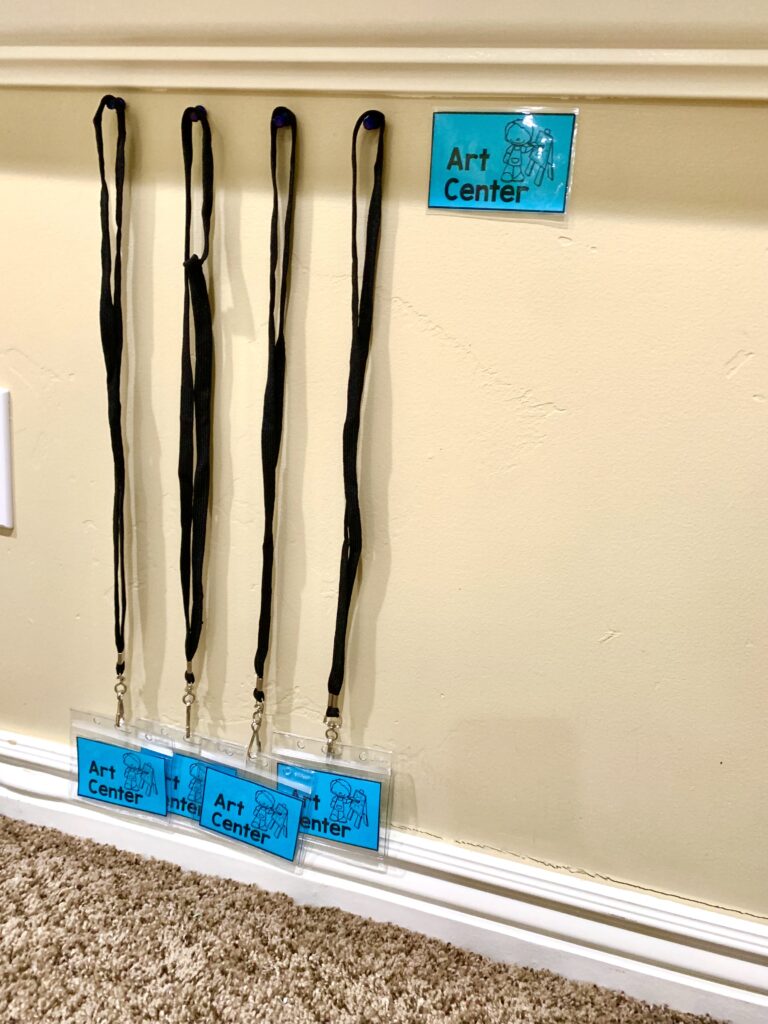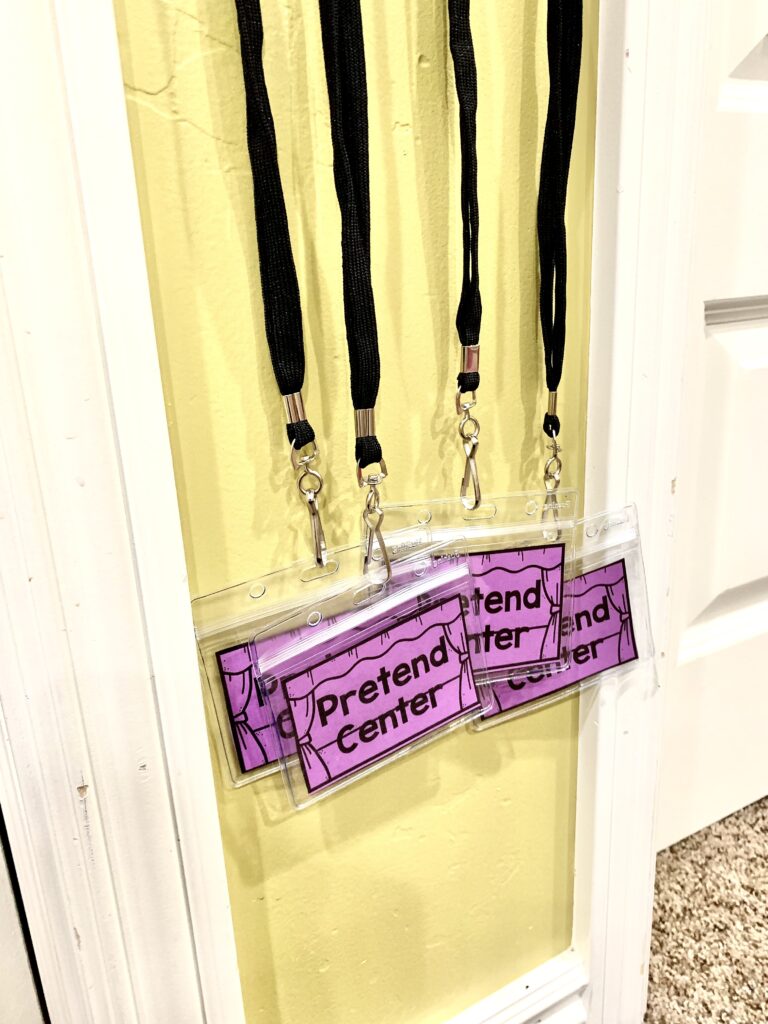Preschool center time can be a challenge for teachers to manage. It is important to create an environment that is both fun and educational for the students, but also allows for the teacher to manage centers and student numbers. This is where color-coded tags can come in handy. By using color-coded tags, teachers can easily manage the number of students in each center and make preschool center time a breeze. In this blog post, we’ll provide tips on how to use color-coded tags to make centers management easier during preschool center time.

This post contains affiliate links- they may give me a small commission at no extra cost to you. I also really appreciate your show of support by using the links here. Thank you.
What is Center Time and Why is it Important in a Preschool Classroom?
Center time is a designated period in the preschool schedule where children are encouraged to engage in independent play and exploration within various learning centers. These centers typically include areas such as blocks, dramatic play, art, sensory, and literacy.
Center time is crucial in a preschool classroom because it provides numerous benefits for the overall development of young children. First and foremost, it allows children to develop their creativity, problem-solving skills, and imagination. They can explore different materials and experiment with various activities, fostering their cognitive and physical growth. I love that centers allow for an incorporation of learning goals with PLAY!
Moreover, center time promotes social interaction and peer collaboration. Children have the opportunity to work and play together, learning essential social skills such as sharing, turn-taking, and communication. It also encourages them to develop a sense of independence and self-regulation as they make choices, manage their time, and engage in activities of their interest.
Center time is an essential component of early childhood education as it allows children to explore, discover, and learn at their own pace. It supports their overall development and provides a foundation for future academic success. By implementing color-coded tags, teachers can further enhance the management and control of center activities, ensuring a smooth and productive center time experience for both students and teachers alike.
Benefits of Using Color-Coded Tags in Center Time
Using color-coded tags in center time provides several benefits for both teachers and students.
First and foremost, these tags help to address the issue of overcrowding and fighting over materials. By limiting the number of students at each center through the use of tags, it ensures that there is enough space and resources for everyone to engage in their chosen activity without feeling overwhelmed or frustrated. This helps to create a more peaceful and inclusive classroom environment, where children can focus on their play and learning without distractions or conflicts.
Additionally, the color-coded tags promote organization and structure during center time. Each tag is associated with a specific center activity, allowing both the teacher and students to easily identify which centers are available and which ones are currently occupied. This visual representation not only helps students to make informed choices about where they want to play, but also enables the teacher to monitor and manage center activities more effectively.
Moreover, the tags foster independence and responsibility among preschoolers. By wearing and returning the tags themselves, students are empowered to take ownership of their choices and actions during center time. They learn to respect and follow the rules of the classroom, understanding that they need to wait their turn if all the tags for a particular center are taken. This promotes patience, self-regulation, and cooperation, important skills that will benefit them in their future educational experiences.
Finally, the use of color-coded tags adds an element of fun and excitement to center time. The bright and vibrant colors of the tags engage the children’s attention and create a visually appealing environment. It adds a sense of novelty and enjoyment to the process of choosing and participating in center activities, making it more enticing and engaging for the preschoolers.
After implementing the color-coded tags, I noticed an immediate improvement in the management and control of center activities. No longer were students fighting over materials or crowding small spaces. Instead, they were able to make informed choices about where they wanted to play based on the availability of tags.
Not only did the tags provide structure and organization, but they also encouraged independence and responsibility among my preschoolers. They quickly learned the routine of taking a tag, wearing it while they played, and returning it when they were finished. This simple action empowered them to take ownership of their choices and actions during center time.
I also found that the tags helped to create a more inclusive classroom environment. With a limited number of tags available for each center, it ensured that every child had an equal opportunity to engage in their chosen activity. Students were more patient and willing to wait their turn, knowing that they would have their chance to play.
Overall, the use of color-coded tags has revolutionized center time in my preschool classroom. It has eliminated overcrowding, promoted organization and structure, fostered independence and responsibility, and added an element of fun. I highly recommend implementing this strategy to effectively control and manage center activities for preschoolers.
Click Here to Get My Tag and Poster Printables.

When I first implemented this, I used tacks in the wall and quickly learned that was not good enough to last- and then I invested in command hooks and it was well worth it. I haven’t had any fall off since!
How to Implement Color-Coded Tags in Your Preschool Classroom
Implementing color-coded tags in your preschool classroom can greatly improve the organization and management of center time. Here are some steps to help you successfully implement this system:
- Determine your centers: Start by identifying the different centers you want to have in your classroom. This could include a writing center, math center, sensory table, art corner, etc. Make sure each center has a designated area in the classroom.
- Create the tags: HERE ARE MY TAGS Print labels on colorful paper to create the tags. I recommend using astrobright paper as it is eye-catching and attractive to young children. It’s not necessary to laminate all the tags as they will be inside a plastic holder on a lanyard, but I laminate one of each center color to stick to the wall and attach one tag to the wall by the hooks for that center. This allows the children to match the tag to the hooks and easily identify where each tag belongs.
- Set the capacity: Decide how many children can safely and effectively play at each center. Consider the size of the center and the materials available. For example, a sensory table may only accommodate two children at a time, while a block area can accommodate more. Create the corresponding number of tags for each center.
- Display the tags: Attach the colorful tags to lanyards and hang them near the center they are associated with. This makes it easy for children to access and return the tags as they move between centers.
- Introduce gradually: At the beginning of the year, take your time introducing the center tags. Spend a whole week focusing on center activities, modeling proper behavior, and practicing how to use materials. Once the children are comfortable with how centers work, introduce the tags. Teach them how to put on tags, hang them up, what to do if there are no tags available, and how to ask for a turn.
- Adjust and practice: Be flexible and willing to make adjustments throughout the year. Monitor how the centers are functioning and make changes as needed. If a center becomes overcrowded or if certain materials require closer supervision, adjust the number of tags accordingly. Continuously practice using the tags and reinforce proper behavior and etiquette during center time.
Implementing color-coded tags in your preschool classroom can revolutionize center time management. It provides a clear visual representation of center capacities, allows children to move freely between centers, and promotes independence and responsibility. With some planning and practice, this system will streamline your preschool center activities and create a more organized and engaging learning environment.

Tips for Managing and Controlling Center Activities with Color-Coded Tags
Managing and controlling center activities in a preschool classroom can be a challenging task. However, using color-coded tags can make the process much easier. Here are some tips for effectively managing and controlling center activities with color-coded tags:
- Establish clear expectations: Before implementing color-coded tags, it is important to clearly explain the rules and expectations to the preschoolers. Let them know that they must wait for a tag to be available before moving to a new center. Spend PLENTY of time at the beginning of the year practicing and modeling behavior. It will pay dividends later.
- Set limits: Assign a certain number of tags for each center activity to ensure that the spaces are not overcrowded. This will help maintain a calm and organized environment.
- Create a visual system: Hang a poster of the name of the center as well as the matching colored tag card (the one laminated one) on the wall near the poster and the hooks for the tags, so it’s clear what the center is, and where the tags belong.
- Monitor transitions: I allow children to move through centers as they desire. They can spend 2 minutes or 10 minutes at the center, but keep an eye on things to help children practice putting on and taking of the tags as they make these changes, so that they develop a habit. Prompt them to return tags promptly to avoid confusion and conflicts.
- Encourage communication: Teach the children to communicate with each other when they want to use a specific center that is currently occupied. This fosters problem-solving skills and encourages cooperation among the children.
- Reinforce positive behavior: Praise the children for following the rules and exhibiting responsible behavior during center time. Positive reinforcement will motivate them to continue using the color-coded tags appropriately.
By implementing these tips, you can effectively manage and control center activities in your preschool classroom using color-coded tags. This system promotes independence, responsibility, and a positive learning environment for all preschoolers.
Strategies for Encouraging Independence and Responsibility during Center Time
During center time, it is important to foster independence and responsibility in your preschoolers. Here are some strategies to help encourage these qualities in your students:
- Model and teach: Show your students how to use the color-coded tags and explain the rules and expectations for center time. Demonstrate how to clean up and switch activities when a tag becomes available. Provide clear instructions and reminders regularly.
- Reinforce positive behavior: Recognize and praise students who are responsible and independent during center time.
- Set clear expectations: Clearly communicate your expectations for behavior during center time. Teach students how to resolve conflicts and share materials with their peers. Encourage them to problem solve independently before seeking assistance.
- Encourage self-reflection: Have students reflect on their behavior and progress during center time. Ask questions such as “What center did you enjoy the most?” or “What could you do differently to improve your experience at the centers?” This helps students develop self-awareness and take responsibility for their actions.
By implementing these strategies, you can empower your preschoolers to become more independent and responsible during center time. Not only will they gain valuable life skills, but they will also develop a love for learning and exploration in a structured and controlled environment.
Conclusion
In conclusion, implementing color-coded tags in your preschool classroom can greatly enhance the management and control of center activities. This simple yet effective system allows for a smooth and organized flow of students between different centers, ensuring that everyone has the opportunity to engage in their preferred activities.
By using color-coded tags, you are providing a visual representation of how many students can be in each center at a time. This promotes fairness and encourages children to take turns and share resources. It also helps them develop a sense of responsibility and independence as they learn to manage their own time and make choices.
Additionally, color-coded tags make it easier for you as the teacher to monitor and keep track of the number of students in each center. You can quickly identify which centers are overcrowded or underutilized and make necessary adjustments to ensure that all students have equal opportunities for learning and play.
Overall, incorporating color-coded tags into your center time routine can greatly simplify and streamline the process. It empowers students, promotes fairness, and provides a structured and organized environment for preschoolers to thrive. So give it a try and see how this simple system can transform your preschool center activities for the better!

Pingback: Beginners Guide to Opening an in-home Preschool – Xiao Panda Preschool